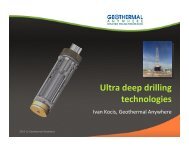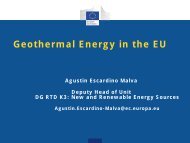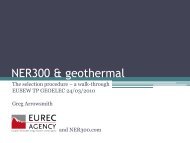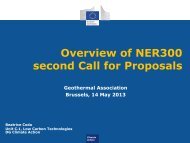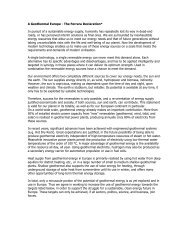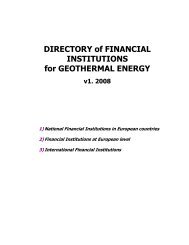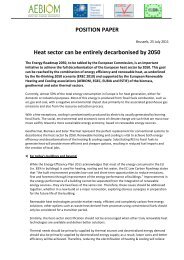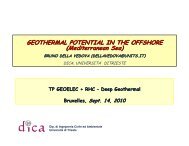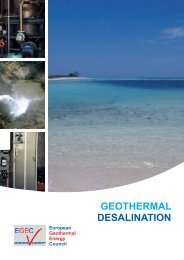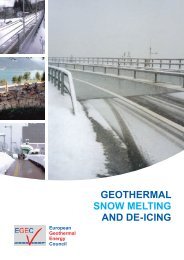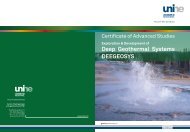Strategic Research and Innovation Agenda for Renewable ... - EGEC
Strategic Research and Innovation Agenda for Renewable ... - EGEC
Strategic Research and Innovation Agenda for Renewable ... - EGEC
You also want an ePaper? Increase the reach of your titles
YUMPU automatically turns print PDFs into web optimized ePapers that Google loves.
<strong>Renewable</strong>Heating & CoolingEuropean Technology Plat<strong>for</strong>mSolar ThermalGeothermalhigh Tsemi-high Tmedium TSolar collectorslow TBiomassCHP plant Industry Buildings Passive buildings, agricultureInput from deep geothermal,biomass, large solar thermalHT storage options LT205090%60%30%0%Efficiency vofelectricity yield70Adapted from drawing byRalf-Roman Schmidt (AIT) -The 13th InternationalSymposium on DistrictHeating <strong>and</strong> Cooling,September 3rd to 4th, 2012,Copenhagen, Denmark.71The concept of SmartThermal Grids is furtherdeveloped in RHC-Plat<strong>for</strong>m(2012d)Tfg = 70˚CFigure 43: Schematic view of a heat cascading network 70100% = 7.6 bn.€100% = 1,180 Mtoe6.4.1 100% <strong>Research</strong> RHC <strong>and</strong> 1% innovation priorities with impact in the Short TermOther H&C 6%Other H&C 14%CCT.17Large scale demonstration of Smart Thermal Grids80%Objective Demonstration of large Smart Thermal Grids which have the following characteristics:• They have to adapt fast to changes in energy supply <strong>and</strong> dem<strong>and</strong>,H&Cin a medium-term33%by60%adaptation of the temperature level in existing networks <strong>and</strong> the installation of new distributedEuratom 69%micro-networks <strong>and</strong> in a long-term by adjusting the network development with urban planning.• They should be intelligently planned <strong>and</strong> operated as well as enable the end-user to interact40%with the heating <strong>and</strong> cooling system.Electricity 21%• They need to be integrated in the whole urban energy system from a spatial point of view(related to urban planning parameters <strong>and</strong> processes) <strong>and</strong> from an energy system point of view20% RES electricity 14% (e.g. with optimised interfaces to other urban networks – electricity, sewage, waste, ICT, etc).• They will help to achieve the highest overall efficiency of the energy system, by choosing theOther energy R&DTransport 32%(non-nuclear) 10%optimal combination of technologies <strong>and</strong> enable a maximum exploitation of available local0%energy resources by cascade usage.• The implemented solutions will be effective in comparison to non-integrated approaches.Solutions Funding will <strong>for</strong> have energy a significant research impact on the Final overall energy urban consumption energy system efficiency when thebroad diffusionunder FP7of(2007-2013)the technology is given, togetherin EUwithin 2010environmental benefits to consumers.• They need to be attractive <strong>for</strong> the citizens <strong>and</strong> investors by increasing the cost efficiency,creating possibilities <strong>for</strong> the customers to participate <strong>and</strong> developing new business models.Advanced district heating systems must be developed that are able to deal with both centralised<strong>and</strong> decentralised, hybrid sources (e.g. solar thermal, biomass, geothermal, heat pumps, wasteheat, waste-to-energy, excess renewable electricity, storage). In addition, smart metering <strong>and</strong>load management systems are needed <strong>for</strong> the integration of thermal <strong>and</strong> electrical grids into aliberalised energy market. Such smart thermal grids have an important potential to meet the loadbalancing needs of combined heat <strong>and</strong> power production in a liberalised market <strong>for</strong> electricity.Private Investments terms 60% of components, specific decentralised European cooling Commission <strong>and</strong> air-conditioning 20% units <strong>for</strong> districtEUR 2,432 million heating systems are needed, as well as new EUR cost-optimized 800 million <strong>for</strong>ms of long-term heat storages(more on this in Chapter 5). Integration <strong>and</strong> st<strong>and</strong>ardisation of thermal components are requiredto decrease their price <strong>and</strong> increase their efficiency. For existing heating grids the integrationof heat pumps <strong>for</strong> active flue gas condensation may be a viable concept, which shouldbe demonstrated. The development <strong>and</strong> demonstration of bi-directional grids may be aninteresting system option <strong>for</strong> new grids. 71State-of-the-artTargetsType of activityThe deployment of Smart Thermal Grids as described above is almost inexistent in Europe.The most advanced systems usually comply Member with only States part 20% of it. This situation comes from thefact that despite cities are composed of a number EUR 800 of million networks – ICT, electricity, heat, cooling,transport, water, etc. – they are developed in parallel, with no real interaction sometimes or evenon a competitive basis• 25% share of renewable energy in District Heating• At least 10 large scale projects using DHC networks as back-up <strong>for</strong> excess renewable electricity• At least 5 large Smart Thermal Grid scale projects complying with the strategic implicationsdescribed above20% Development / 80 % DemonstrationTfg = 120˚CTfg = 200˚C69



